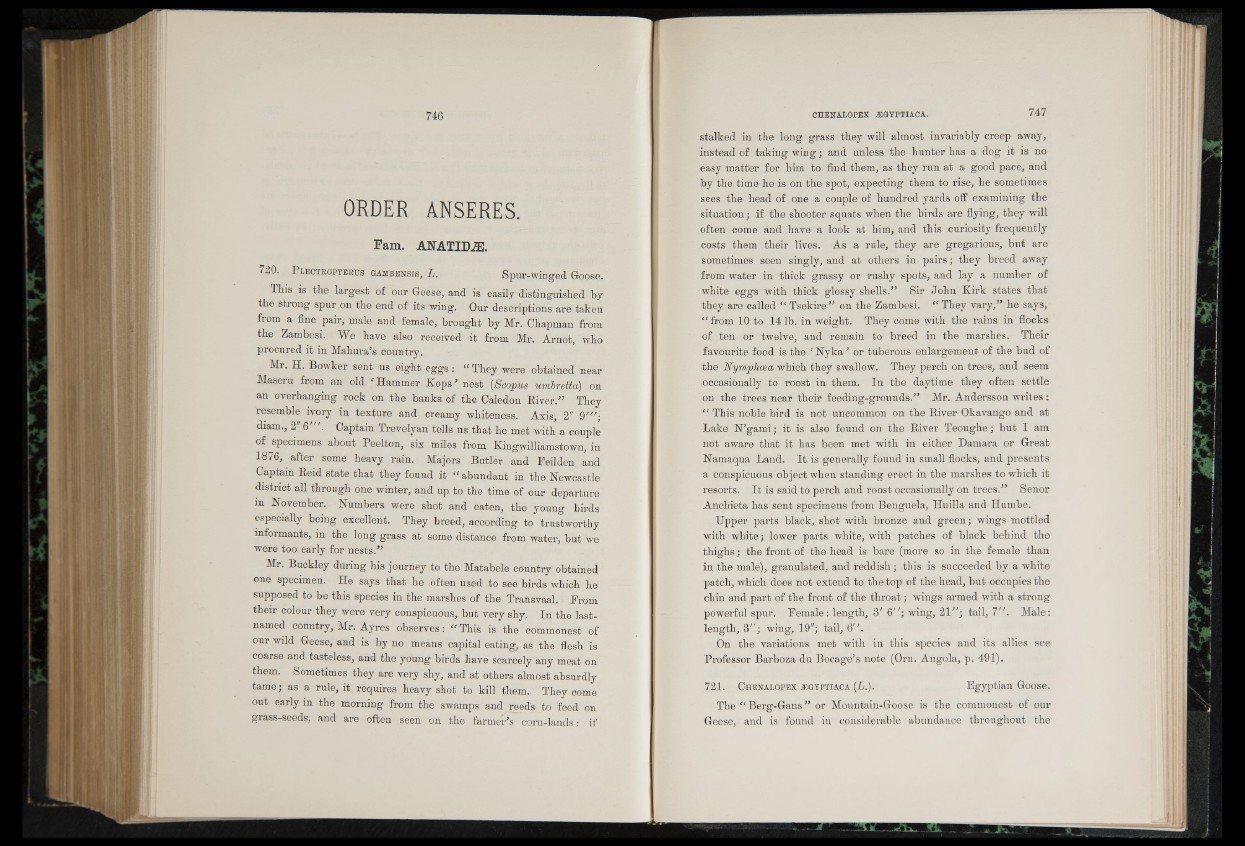
ORDER ANSERES.
Fam. ANATID2E.
720. P l ec tro pt erx js g a m b e n s is , L. S p u r - w i n g e d G o o s e .
This is the largest of our Geese, and is easily distinguished by
the strong spur on the end of its wing. Our descriptions are taken
from a fine pair, male and female, brought by Mr. Chapman from
the Zambesi. We have also received it from Mr. Arnot, who
procured it in Mahura's country.
Mr. H. Bowker sent us eight eggs: “ They were obtained near
Maseru from an old 'Hammer Kbps' nest (Scopus umbretta) on
an overhanging rock on the banks of the Caledon River." They
resemble ivory in texture and creamy whiteness. Axis, 2""9'//;
diam., 2" 6'". Captain Trevelyan tells us that he met with a couple
of specimens about Peelton, six miles from Kingwilliamstown, in
1876, after some heavy rain. Majors Butler and Peilden and
Captain Reid state that they found it "abundant in the Newcastle
district all through one winter, and up to the time of our departure
m November. Numbers were shot and eaten, the young birds
especially being excellent. They breed, according to trustworthy
informants, m the long grass at some distance from water, but we
were too early for nests."
Mr. Buckley during his journey to the Matabele country obtained
one specimen. He says that he often used to see birds which he
supposed to be this species in the marshes of the Transvaal. • From
their colour they were very conspicuous, but very shy. In the last-
named country, Mr. Ayres observes: “ This is the commonest of
our wild Geese, and is by no means capital eating, as the flesh is
coarse and tasteless, and the young birds have scarcely any meat on
them. Sometimes they are very shy, and at others almost absurdly
tame; as a rule, it. requires heavy shot to kill them. They come
out early in the morning from the swamps and reeds to feed on
grass-seeds, and are often seen on the farmer's corn-lands: if
stalked in the long grass they will almost invariably creep away,
instead of taking wing; and unless the hunter has a dog it is no
easy matter for him to find them, as they run at a good pace, and
by the time he is on the spot, expecting them to rise, he sometimes
sees the head of one a couple of hundred yards off examining the
situation; if the shooter squats when the birds are flying, they will
often come and have a look at him, and this curiosity frequently
costs them their lives. As a rule, they are gregarious, but are
sometimes seen singly, and at others in pairs; they breed away
from water in thick grassy or rushy spots, and lay a number of
white eggs with thick glossy shells." Sir John Kirk states that
they are called “ Tsekire" on the Zambesi. “ They vary," he says,
“ from 10 to 141b. in weight. They come with the rains in flocks
of ten or twelve, and remain to breed in the marshes. Their
favourite food is the ‘ Nyka ' or tuberous enlargement of the bud of
the Nymphoea, which they swallow. They perch on trees, and seem
occasionally to roost in them. In the daytime they often settle
on the trees near their feeding-grounds." Mr. Andersson writes :
“ This noble bird is not uncommon on the River Okavango and at
Lake N'gami; it is also found on the River Teoughe; but I am
not aware that it has been met with in either Damara or Great
Namaqua Land. It is generally found in small flocks, and presents
a conspicuous object when standing erect in the marshes to which it
resorts. It is said to perch and roost occasionally on trees." Senor
Anchieta has sent specimens from Benguela, Huilla and Humbe.
Upper parts black, shot with bronze and green; wings mottled
with white; lower parts white, with patches of black behind the
thighs; the front of the head is bare (more so in the female than
in the male), granulated, and reddish; this is succeeded by a white
patch, which does not extend to the top of the head, but occupies the
chin and part of the front of the throat; wings armed with a strong
powerful spur. Female: length, 3' 6"; wing, 21"; tail, 7". Male:
length, 3"; wing, 19"; tail, 6".
On the variations met with in this species and its allies see
Professor Barboza du Bocage’s note (Orn. Angola, p. 491).
721. C h e n a l o p e x ^¡g y pt ia c a (L.). Egyptian Goose.
The “ Berg-Gans ” or Mountain-Goose is the commonest of our
Geese, and is found in considerable abundance throughout the